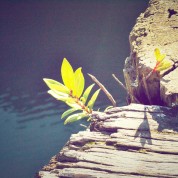
Sustainability is a beloved word often used by earth lovers and green-washers alike. This term embodies many definitions and identities from ecology to sociology, marketing to spirituality, science to design. It typically balances the three areas of ecology/environment, economy/employment, equity/equality. The many ways of understanding sustainability speaks to the fact of its relevancy in our time. Sustainability connects us to the fact of our interconnectedness, our place in the universe, and the truth of our aliveness.
The concept of sustainability was developed as a response to the harmful (i.e. non-sustainable) industrial, business, corporate, wasteful, and environmental practices of our time. Sustainability doesn’t actually exist in a world where we are living in harmony with our planet, rather, it arose from the duality created from toxins, carbons, gases, and waste generated from the time of the industrial revolution to present.
So what does sustainability mean? These days, many people use the word, and, many use it in different ways. The term can be used to describe marketing techniques to greenwash corporate practices and create a good feeling around buying certain products. It can be used to describe the sustainability of a single entity keeping hold of its dominance in the marketplace. In a vague sense it means anything from environmentally better to cool (Engelman, p. 3). But a firmer and more honest definition eludes to the fact of our impermanence and interdependence. The term can be used to explore the ways in which we relate to one another and make choices that affect others long into the future. The term can be used by environmentalists to describe efforts to make the earth a place habitable and safe for human life and health, and the term can also be rejected by environmentalists who find it meaningless when used in so many different ways.
I define sustainability as the activity of living in harmony with our planet. I see this as a way to realize the intimate interrelationships between humans and nature. It is the ability to act in a way that does not harm future or present generations, and enhances the adventure of life. Sustainability is nonviolent. Sustainability is community, it is the depths of our soul, it is the way we behave and the impact we have on one another and the environment. In short: sustainability is the activity of life enhancing life.
A discussion about sustainability is important because humans are an integral part of nature, interconnected with the web of life. What we do to harm the environment has the potential to harm our own well-being and the well-being of future generations. We cannot survive without plants and animals and clean air and water – all of which we are eliminating at a clipping pace. Plants and animals don’t need to address sustainability in the way that humans do because they don’t harm their own habitats, and so sustainability is a uniquely human issue…and yet it is intended to benefit all beings. We are really talking about survival. This is especially relevant in an educational discourse because it is our responsibility to teach our children how to orient themselves and find their way in the universe. It is our nature to want our children to flourish, and it is our job to create a world in which they can live well. An understanding of sustainability is relevant in a social discourse because a culture grows into the future they hold as a collective.
Many brilliant minds have recognized and advocated for this discourse. Sustainability finds its roots in the tradition of experiencing the human spirit in nature. Indigenous peoples around the world have an inherent human-nature connection woven into their culture and daily life. We are familiar with sustainability through the transcendentalist movement of the 1880’s, where authors such as Emerson and Thoreau connected to ways of being and living simply. These stories are as much of our American identity as the Declaration of Independence. I remember learning in my college English classes that the tradition of essaying, to which Emerson and Thoreau contributed, was more a form of philosophy in its essence. The philosophy speaks to the need to learn from our environment, the instinct of humility. According to Thoreau, “I went to the woods because I wished to live deliberately, to front only the essential facts of life, and see if I could not learn what it had to teach, and not, when I came to die, discover that I had not lived”. The instinct described here is important in an educational and social context because it speaks to the underlying need in all life, human and animal and plant alike. Ideas like this connect us to our similarities and common longings. As Aldo Leopold noted, “Animal instincts are modes of guidance…Ethics are possibly a kind of community instinct in the making” (Edwards, p. 13). Leopold’s ethic connects us to a guidance from within, instead of being led by outer drives of greed, anger, and separateness. In remembering the wisdom within, we remember the inter-dependence between the ecosystem and our survival.
Today, there are still more definitions of sustainability. There is realistic and fearful sustainability that sees imminent demise based on soil erosion and diminishing food supply, as described by Lester Brown of the Earth Policy Institute. There is hopeful sustainability for Joanna Macy that views our problems as the great adventure of our time, and offers guidance through a practice of having a clear view of reality, identifying hope for a new direction, and taking steps towards that path. There is spiritual sustainability that teaches about the peace within. For Thich Nhat Hanh, sustainability is the breath available to us in each moment. There is personal sustainability and global sustainability. While none of these is all-encompassing, all of these understandings work together to provide a dynamic, yet difficult to define, understanding of sustainability. Each speaks to the original Latin adjective meaning “capable of being maintained in existence without interruption or diminution”. The diversity of definitions can actually be considered a strength of the movement, a testament to how many walks of life care about the matter.
The concept of personal and global sustainability was actually pivotal in my educational and professional journey. Dr. Dean Ornish of the Preventive Medicine Research Institute described the idea that what is personally sustainable is globally sustainable, and vice versa, and suddenly my work in health care took on a whole different perspective. I saw with new eyes the importance of working for the planet as a means to heal human health. I knew instinctively that our problems cannot be solved by harvesting more from the earth and treating symptoms, rather, they will be solved by dealing with the root harm of nature instead. When we are in harmony with the environment, disease does not manifest. The more we take care of our own bodies, the more we care for the body of the planet. This means tuning into our daily needs and connection with the earth. John Muir’s musings reflect the universal requirement for natural space as a healing modality, “everybody needs beauty as well as bread, places to play in and pray in, where nature may heal and give strength to body and soul alike”. Eating locally, with the seasons, biking and walking, and connecting and networking in our own communities are all ways to ease the global environmental burden while supporting our regions and taking care of ourselves and each other.
For me, sustainability is always personal. I ask myself almost everyday what I can sustain in terms of relationships, workload, habits, footprint. Sustainability is community, it is the depths of our soul, it is the way we behave and the impact we have on one another and the environment, “at a fundamental level, members of a sustainable community understand that the well-being of the individual and the larger community are interdependent” (Edwards, p. 23). I know that acting with harm hurts my spirit, and what I do to harm another hurts me, because I feel the web of life. The more sustainable my neighbor, the more I am supported in my own efforts. In short: sustainability is the activity of life enhancing life.
Spending time in nature helps us see our interdependence of everything around us, and teaches us the importance of community and stewardship. This can help us develop an eco-philosophy, of seeing humans as a keystone species in nature, as active and creative participants. When viewed from this perspective, our role on the individual level is suddenly seen as paramount to and connected with the larger question of global sustainability… Overall, sustainability starts from within each person. Although the textbook version of sustainability, statistical evidence, and technical step-by-step approach to reaching sustainability are great starting points and valuable information, there is more needed on the level of individual commitment and awareness. This then connects to cultivating personal health, mindfulness, and establishing a connection with nature. The healthier and more connected with the environment we all are on an individual level, the stronger our community ties and global movement, and ability to transform our cultural paradigm out of its current mode of destruction. Taking time out of our busy lives, being mindful of how our patterns of behavior contribute to the larger whole, and developing an eco-philosophy are all spiritual developments that are essential pieces of the puzzle needed for the sustainability revolution to succeed.~ From Sustainability: The True Definition by Maggie Field
References:
Edwards, Andres R. (2005). The Sustainability Revolution: Portrait of a paradigm shift. Gabriola Island, Canada: New Society Publishers.
Engleman, Robert. (2013). Beyond Sustainababble. In The Worldwatch Institute (Ed.), State of the World 2013: Is sustainability still possible? (pp. 3-18). Washington, DC: Island Press.






